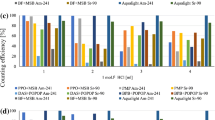Abstract
In this paper the quenching effect of ethanol in NE 267 liquid scintillation cocktail is investigated when14C is measured at environmental concentrations. The results obtained show that with a proper selection of amplifier gain and discriminators setting it is possible to achieve efficiency as high as 80% and up to 5 g of sample carbon in the cocktail. This is very important for the direct measurement of14C for environmental protection purposes in different chemical forms without applying the standard radiocarbon procedures. In all cases the quenching effect of the chemical form in which14C is being measured has to be determined.
Similar content being viewed by others
References
K. E. Zimen, Proc. 8th Conf. on Radiocarbon Dating, Royal Soc., New Zealand, Wellington, 1972, p. 85.
J. S. Lopez, et al., Low Radioactivity Measurement and Applications, P. Povinec, S. Usacev /SPN, Bratislava, 1977/, p. 265.
A. Walton, M. S. Baxter, Radiocarbon Dating and Methods of Low Level Counting, IAEA, Vienna, 1967, p. 125.
K. N. Kostadinov, Y. Yanev,Nucl. Instr. Meth. B 17 /1986/ 511.
Author information
Authors and Affiliations
Rights and permissions
About this article
Cite this article
Kostadinov, K., Yanev, Y. & Fodor-Csányi, P. Certain aspects of the liquid scintillation measurement of14C in ethanol. Journal of Radioanalytical and Nuclear Chemistry Letters 118, 373–378 (1987). https://doi.org/10.1007/BF02170471
Received:
Accepted:
Issue Date:
DOI: https://doi.org/10.1007/BF02170471




